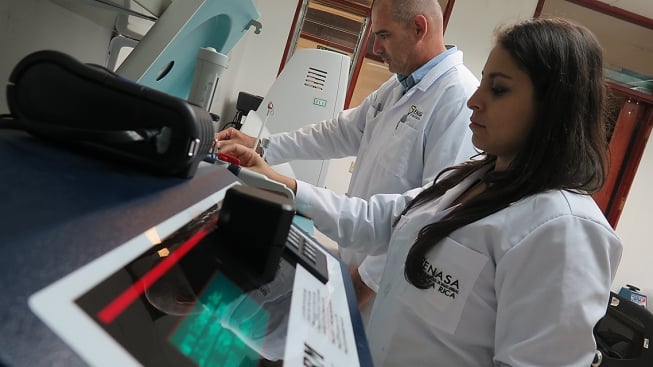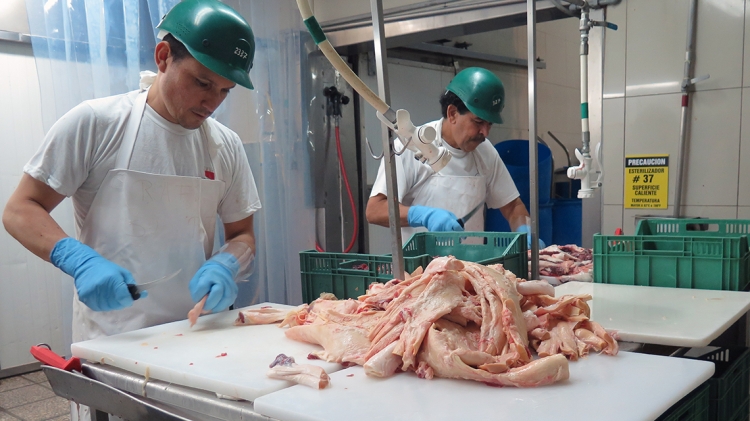Costa Rica News – Costa Rica no longer depends on laboratories abroad to guarantee food safety and to stay competitive thanks, in part, to nuclear technology and to the support of the IAEA and the Food and Agriculture Organization of the United Nations (FAO).
 “We analyse 310 samples a month, 25% more than we did two years ago,” said Yajaira Salazar, food safety expert at Costa Rica’s National Laboratory for Diagnosis and Research in Animal Health (LANASEVE), while walking in her lab amid polished machines and flashing green lights. Salazar and her colleagues have participated in several IAEA training courses and fellowships and can now perform marine biotoxin analysis and quality management, among others.
“We analyse 310 samples a month, 25% more than we did two years ago,” said Yajaira Salazar, food safety expert at Costa Rica’s National Laboratory for Diagnosis and Research in Animal Health (LANASEVE), while walking in her lab amid polished machines and flashing green lights. Salazar and her colleagues have participated in several IAEA training courses and fellowships and can now perform marine biotoxin analysis and quality management, among others.
Pesticides, veterinary drug residues, heavy metals, marine biotoxins, and other organic and inorganic pollutants can all contaminate our food. “To detect these, Costa Rica needs the finest, newest technology manned by well-trained personnel,” said Marietta Ureña Brenes, Director of LANASEVE. “We need to stay ahead of the game.”
Since 2015, LANASEVE’s experts have been learning the latest nuclear and conventional analytical technology to detect contaminants and residues in food, receiving state-of-the-art equipment and expertise through an IAEA technical cooperation project. This food safety facelift has helped Costa Rica’s consumers, producers and exporters alike.
Fish and Cows
To Costa Rican fish producers, sending their samples for analysis to LANASEVE instead of abroad means less money and a shorter turnaround time. While they used to send almost 200 samples a year to laboratories in Ecuador and Chile to check for suspicious harmful substances and comply with EU rules, now LANASEVE analyses these in Heredia north of San José, saving each producer at least EUR 27 000 per year.
Meat producers are also benefiting from these new analytical services. CIISA, a Costa Rican company that sells beef and pork in the country, the USA, Russia and Europe, among others, also depends on LANASEVE’s precise nuclear and isotopic analytical technology to ensure its products are innocuous and meet market requirements.
“It’s better to prevent than to cure,” said María José Arroyo, quality expert at CIISA. Every week, veterinary inspectors prepare samples of beef and pork for LANASEVE to collect and analyse, a service they could not receive before.
Detecting traces of veterinary drug residues in beef, for example, can protect consumers from eating that meat and prevent them from creating resistance to certain medicines in the long term. “We need our scientists close to guarantee that our food is safe and of good quality,” Arroyo added.
LANASEVE’s enhanced capacity to monitor veterinary drug residues and related contaminants in animal products using nuclear or isotopic techniques has not only boosted the country’s ability to maintain its food export markets to the EU, the USA and other Latin American countries, but also assisted in capturing newer markers such as China.
International standards
Having the capacity to ensure food safety locally is a game changer for exporters too. Besides affecting public health, food contamination can have a devastating economic impact on international trade.
“Globally, technology is getting better at detecting very small traces of residues in food,” said Mauricio González, another food safety expert at LANASEVE who has also been trained through the IAEA’s technical cooperation programme. “Which is a good thing for consumers, but which means that codes are getting stricter for exporters.” With today’s rapidly evolving international food safety laws, Costa Rica has had to adapt.
Using the newly learnt nuclear analytical techniques and equipment, experts at LANASEVE can detect very small traces of contaminants, medicine residue and pesticides in food samples, meeting international requirements. “The more sensitive the equipment, the better we can guarantee the absence of any unwanted products in our food,” González said.
The new capacities have also helped LANASEVE open up to other areas, such as analysing a wider variety of animal products and imported food. Thanks to the nuclear techniques, for example, the team at LANASEVE detected malachite green, a dye that is both potentially carcinogenic and could damage the DNA, in imported fish products. After these findings, Costa Rica stopped imports from these providers. Examples like these demonstrate why it is necessary to build national laboratory food-testing capabilities, said James Jacob Sasanya, food safety specialist at the Joint FAO/IAEA Division of Nuclear Techniques in Food and Agriculture.
“Costa Rica has always made efforts to protect public health,” said Bernardo Jaén Hernández, Director General of Costa Rica’s National Animal Health Service (SENASA), which LANASEVE is part of. “And to protect public health you need to have strong capacities in place to check what the country is producing, exporting and even importing.”
A new IAEA technical cooperation project will support LANASEVE in further improving its technical and analytical capabilities, said Raquel Scamilla Aledo, manager of these projects at the IAEA. “As one of its national development priorities, Costa Rica has asked for more support in analysing marine biotoxins, pesticides and veterinary drugs that are not included in its current range of tests,” she said. “Costa Rica also aims to increase laboratory services to meet new European Union and other food export market regulations.”
Jointly with the FAO, the IAEA assists countries in adopting nuclear and related techniques that provide a science-based solution to regulating food safety — making analytical methods available in laboratories world-wide. This also includes food irradiation, analysis of various food and environmental contaminants as well as food authenticity.
“Being able to offer improved services benefits consumers, producers, suppliers, importers, exporters,” Ureña Brenes said. “In essence, the country and the world.”
Laura Gil, IAEA Office of Public Information and Communication
